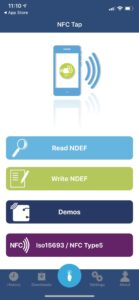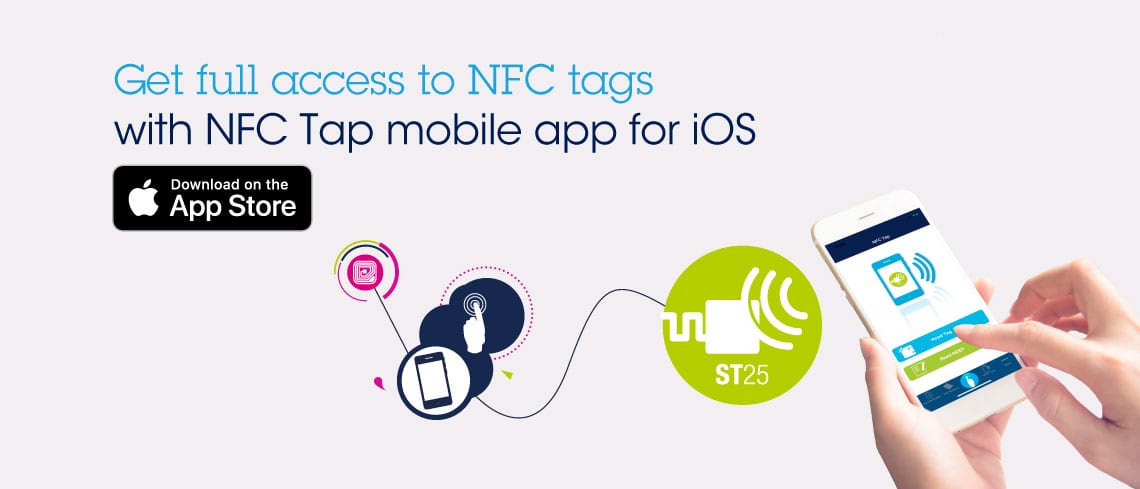A few weeks ago, Apple released iOS 13, and today, we are proud to announce the availability, in the App Store, of NFC Tap 2.0, ST’s reference application that takes advantage of the new features present in the latest operating system for iPhone. Users can now write NFC Data Exchange Format (NDEF) tags as well as read and write user memory content on NFC Type-5 tags. A few months ago, after Apple’s Worldwide Developers Conference (WWDC), we shared example codes to help developers working with our devices take advantage of Type-5 custom commands on iOS 13 or use the new features in original ways. Today, engineers can enjoy the entire source code of our NFC Tap (STSW-ST25IOS001) app to see how we implemented the new functions or optimized certain aspects of our applications.
Two years ago, Apple introduced CoreNFC, a framework that inaugurated NDEF tag reading on their devices. Last year, iOS 12 brought native NDEF reading, meaning that certain tags no longer needed a dedicated application. Users could put their Apple devices next to a tag, and the operating system would ask if the user authorized the opening of a link, a phone call, or SMS, for instance. This year, Apple went much further to support all the Type-5 features, thus building on the previous innovations to meet the rapid technological changes that are bringing NFC to products that had no onboard electronics before or transforming the way we interact with our vehicles. Let’s look at three applications that are now possible on iPhone third-party apps thanks to iOS 13.
1. Brand Interaction

The ability to write NDEF tags enables vastly more intricate brand interactions. In its demo at WWDC19, Apple gave the example of a fishmonger capable of applying sales to different products as the consumer scanned their tags with a phone. Writing to the tag ensures that a specific discount only works once, thus limiting the potential for fraud or abuse. Similarly, engineers that use an ST25 tag and their own iOS 13 application could call the write NDEF function to track the ownership of a device for warranty purposes, or even update the tag with the customer’s information to make its retrieval easier in case someone misplaces the product. Design teams can thus add features and create interactions that weren’t possible on iOS until now to differentiate themselves from the rest of the industry.
2. Smart Customer Care and Smart Factory Management Applications
The ST25 dynamic NFC devices were among the first to pass the Tag Certification Program, and today, iOS developers can take full advantage of their dual interface. For instance, a smart factory could render the use of small on-product displays obsolete since an iPhone could show a graphical user interface, receive the new user settings, and apply them to the system through the dynamic NFC tag by sending them to the host MCU using I2C. Similarly, a vast number of repair calls for white appliances require a second visit because the responding technician doesn’t have the right component on hand. A dynamic tag on the appliance allows the consumer to communicate the current bill of material to the technician who can then update logs and BOMs by using the NFC dynamic tag to write new information onto the system’s memory once the repair is complete.
3. Safeguarding Sensitive Systems and Information

iOS 13 inaugurates Type-5 custom commands support on iPhones. Put simply; they allow manufacturers to associate certain operations established by the NFC Forum to a code that ranges from 0xA0 to 0xDF (0x00 excluded). In our previous blog post, we showed that developers using our devices could call, among others, 0xDB to read a digital signature, 0xB1 to update the Kill password, 0xB2 to lock it indefinitely, or 0xA6 to mute the tag, meaning that the RF will no longer answer any command. It thus opens the door to extensive security features that can protect a system in ways that were simply impossible before. For instance, if someone steals an administrator’s phone and tries to use it to access an industrial appliance through its NFC interface, the system could require a password, and potentially mute the device as a safeguard after multiple wrong entries.
